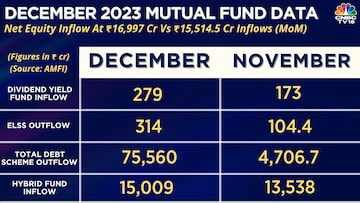
Debt funds witnessed an outflow of ₹75,560 crore in December, marking a rise from the previous month's ₹4,706.7 crore outflow, according to Association of Mutual Funds in India (AMFI) data. Liquid funds saw ₹39,675 crore outflow, while credit risk funds experienced an outflow of ₹368 crore as compared to ₹253.7 crore in November.
Live TV
Loading...
Conversely, corporate bond funds observed an inflow of ₹188 crore, contrasting the previous month's outflow of ₹1,578.4 crore.
Other categories with less than one year of maturity also witnessed net outflows.

Himanshu Srivastava, Associate Director at Morningstar Investment Research India, attributed the December outflows to corporate advance tax requirements, primarily due to quarter-end obligations. Liquid funds bore the brunt of this trend, witnessing the highest net outflows, along with other categories with less than a year's maturity.
"While the broader consensus is that the increasing interest rate cycle has peaked, there is a lack of clarity over the timing of the possible reversion in the interest rate scenario. Such a scenario has complicated investment decisions in this segment for investors. Moreover, the robust performance of equity markets has been drawing increased attention from investors, resulting in them shifting from other asset classes towards equities," Srivastava said.
In an earlier conversation with CNBC-TV18, Sandeep Yadav, Head of Fixed Income at DSP Mutual Fund, stressed the cyclical nature of debt funds in response to ongoing interest rate cycles.
Yadav added that the current high yields are an opportune moment for investors, indicating that as yields decrease, debt funds become more attractive.
Yadav emphasised the need for a vigilant approach, advocating close monitoring of RBI policy rates, fiscal policies, and global trends influencing yields and equity indices.
He advised investors to consider the aggressive segments within the debt category, especially in declining yield scenarios, recommending long-duration bonds and dynamic bond fund categories.
Here are the 5-year and 10-year returns of some of the Dynamic Bond Funds:
| Scheme Name | Crisil Rank | AuM (Cr) | YTM | 5-Year Return (%) | 10-Year Return (%) |
|---|---|---|---|---|---|
| UTI-Dynamic Bond Fund - Direct Plan - Growth | 3 | 434.20 | 7.40 | 6.37 | 8.03 |
| Mirae Asset Dynamic Bond Fund - Direct Plan - Growth | 1 | 195.08 | 7.71 | 7.13 | - |
| ICICI Prudential All Seasons Bond Fund - Direct Plan - Growth | 3 | 11,511.25 | 8.05 | 8.42 | 9.76 |
| Axis Dynamic Bond Fund - Direct Plan - Growth | 1 | 1,737.82 | 7.65 | 7.62 | 8.71 |
| Kotak Dynamic Bond Fund - Direct Plan - Growth | 3 | 2,450.51 | 7.86 | 7.76 | 8.60 |
| 360 ONE Dynamic Bond Fund - Direct Plan - Growth | 2 | 744.01 | 7.79 | 6.75 | 7.84 |
| HDFC Dynamic Debt Fund - Direct Plan - Growth | 4 | 641.09 | 7.56 | 6.46 | 7.86 |
| Canara Robeco Dynamic Bond Fund - Direct Plan - Growth | 4 | 115.39 | 7.39 | 6.54 | 7.74 |
| UTI-Dynamic Bond Fund - Direct Plan - Growth | 3 | 434.20 | 7.40 | 6.37 | 8.03 |
(Source: Moneycontrol)
(Edited by : Amrita)
First Published: Jan 8, 2024 3:32 PM IST
Note To Readers
The views and investment tips expressed by investment experts on CNBCTV18.com are their own and not that of the website or its management. CNBCTV18.com advises users to check with certified experts before taking any investment decisions.
Check out our in-depth Market Coverage, Business News & get real-time Stock Market Updates on CNBC-TV18. Also, Watch our channels CNBC-TV18, CNBC Awaaz and CNBC Bajar Live on-the-go!


Supreme Court says it may consider interim bail for Arvind Kejriwal due to ongoing Lok Sabha polls
May 3, 2024 4:57 PM
10% discount on fare on Mumbai Metro lines 2 and 7A on May 20
May 3, 2024 2:40 PM

